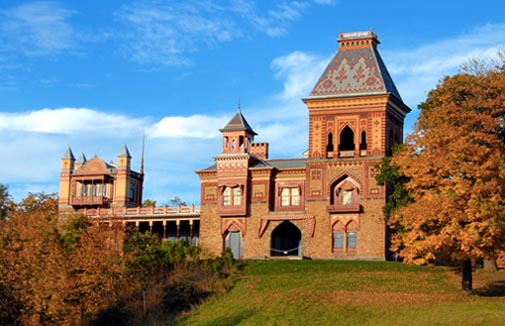Travel: Hudson New York
 Steeped in historic value, Hudson NY is a town worth exploring. A two hour pleasant train ride along the Hudson starts you off on this relaxing journey. Having been called one of the richest dictionaries of architectural history in New York State and a treasure house of architectural styles spanning from 18th century Federal buildings to 20th century arts and crafts houses. The County Courthouse for example is a Beaux Arts style building constructed of Vermont marble and was designed by the architects that designed NYC Grand Central Station.
Steeped in historic value, Hudson NY is a town worth exploring. A two hour pleasant train ride along the Hudson starts you off on this relaxing journey. Having been called one of the richest dictionaries of architectural history in New York State and a treasure house of architectural styles spanning from 18th century Federal buildings to 20th century arts and crafts houses. The County Courthouse for example is a Beaux Arts style building constructed of Vermont marble and was designed by the architects that designed NYC Grand Central Station.
This small city on the banks of the Hudson River also shares its nostalgic historic time with bootlegging and prostitution. It was widely known “as the little town with the big red light district†known for its bootlegging most importantly.
Hudson was organized by Quakers from Nantucket and Martha’s Vineyard who needed an inland port for their whaling ships. You can see that the streets are very wide, for when the whales would come in, that would be dragged up the road. At that same time they put up with the grog shops and bawdy houses for transients, sailors and wagon drivers who needed an outlet after being sea-bound for months at a time. During the 20’s and 30’s the going rate for a prostitute was $2 for twenty minutes.
The place to stay: BARLOW HOTEL, 542 Warren Street
Set in an art deco building, this place is pure luxury with a garden patio. Reminiscent of an old schoolhouse it also has a contemporary boutique offering with an amazing fireplace in every room. The hotel has retained the quirkiness of this historic building. There is a European sunken tub and also an off the hook spa shower. The chalk board at the foot of the stairs tells guests about events and the weather. Another nice feature is a coffee maker by Keurig and amenities from Lather. The concierge desk is really helpful!
The gallery to see: Jeff Bailey Gallery 127 Warren Street
Set in a gorgeous townhouse, Jeff has impeccable taste on all levels: his gallery, his artists, his homes that he has restored. Featuring works in a wide range of media fuel this exhibition space that focuses on up and coming artists. He also has a beautiful garden in the back where he shows sculptures. Constantly changing exhibitions and bringing in new artists, this gallery sets itself apart from all the rest there.
The place to dine: Swoon Kitchenbar, 340 Warren Street
Locally sourced and wildly inventive New American cuisine, at its heart, Swoon Kitchenbar is a husband and wife team who put together an incredible culinary experience. I recommend the crab risotto and the Health Margarita, with tequila blanca, fresh pink grapefruit, cointreau, and lime according to the owner and chef… Jeff Gimmel. who trained and worked in the South of France. The sensibilities of the food are also reflected in the décor. The bar is sourced from old factory truss, ie support beams from a factory, 22 feet of hemlock pine. The drink menu is amazing and filled with inventive cocktails like the Health Margarita mentioned above or the Bronx Botonist made with botanist islay gin, sweet & dry vermouth, and fresh OJ.
Historic Places to See: The Hudson Opera, 327 Warren Street
Built in 1855, the buildings showpiece was and still is a magnificent auditorium. Going under a major renovation right now, I got a hard hat tour of the space. Grand yet intimate, it was used for everything from theatrical productions to cotillions and poultry shows. Frederic Church showed his paintings there. Bret Harte read his poems and Henry Ward Beecher gave a rousing abolition speech and it’s been noted that Susan B. Anthony visited at least twice, the first time lecturing about abolishing slavery and the second time to rally for support for women’s suffrage. In 1914, Teddy Roosevelt regaled a crowd with his adventures in Africa. Currently undergoing a massive restoration this unique space also has an art gallery.
Historic Site: OLANA
A 19th century news account about Olana remarked on the views, from the green mountains in the northeast, to the south, past Mt. Everett in Massachusetts and the smaller peaks in Connecticut, around the Catskills on the west, is a grand sweep of country. The Painter Frederic Church acquired and developed a private landscape which afforded views of regional natural wonders and neighboring land forms. In fact, Olana is one of the few intact artists’ home and studio and estate complexes in the U.S. The main building is an architectural masterpiece, with the exterior being a mix of stone and brick. The poly-chrome stenciled villa is done in a style that manages to blend Victorian with Persian and Moorish styles. The interior remains much as it was during Church’s lifetime, exotically decorated with objects from his global adventures, shipping them all back and having them brought up a lovely long driveway, which reminded me of the South of France lined trees and meadows that seem endless. There are over 40 paintings of Church and his friends. The house is intricately stenciled inside and out. Church designed the stencils based on his travels in the Middle East.


